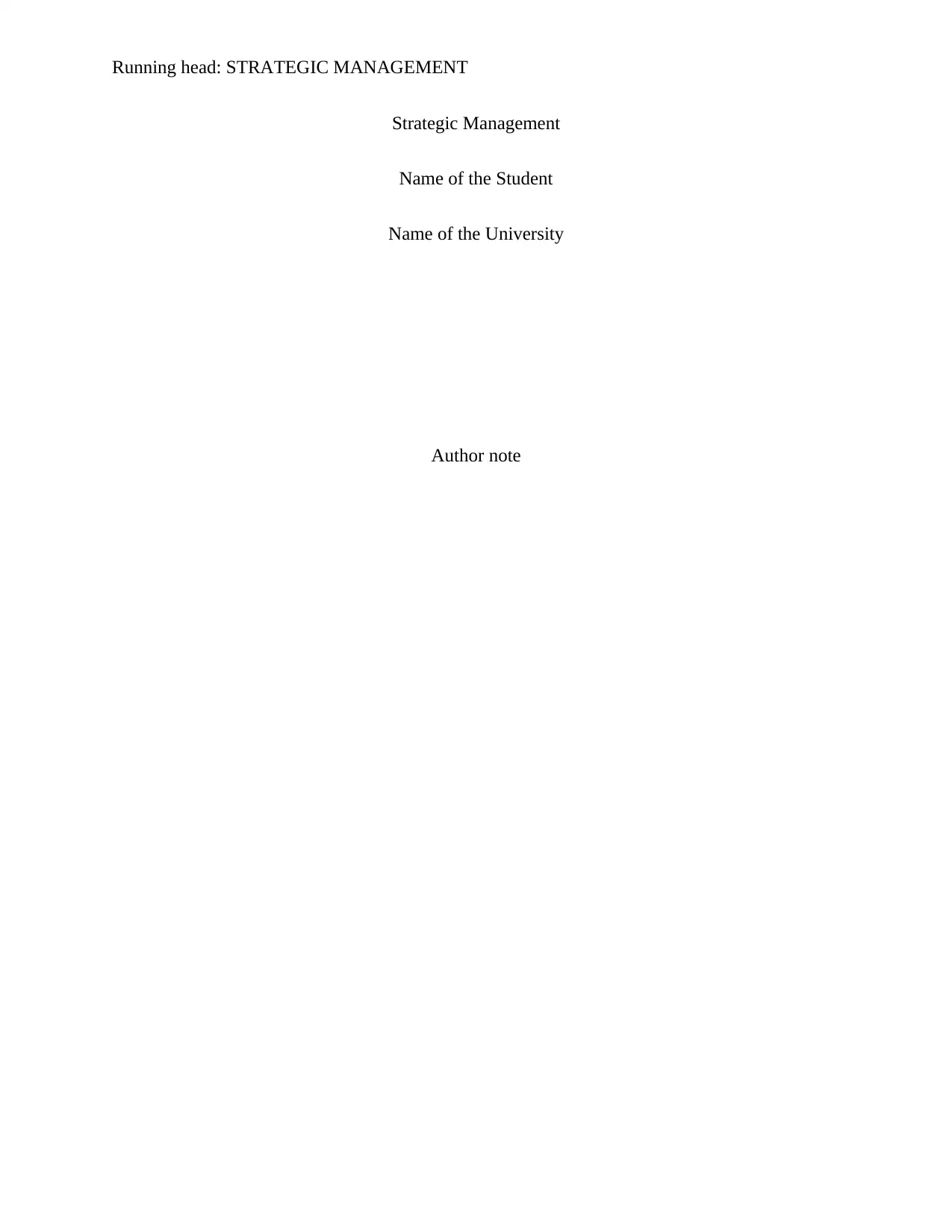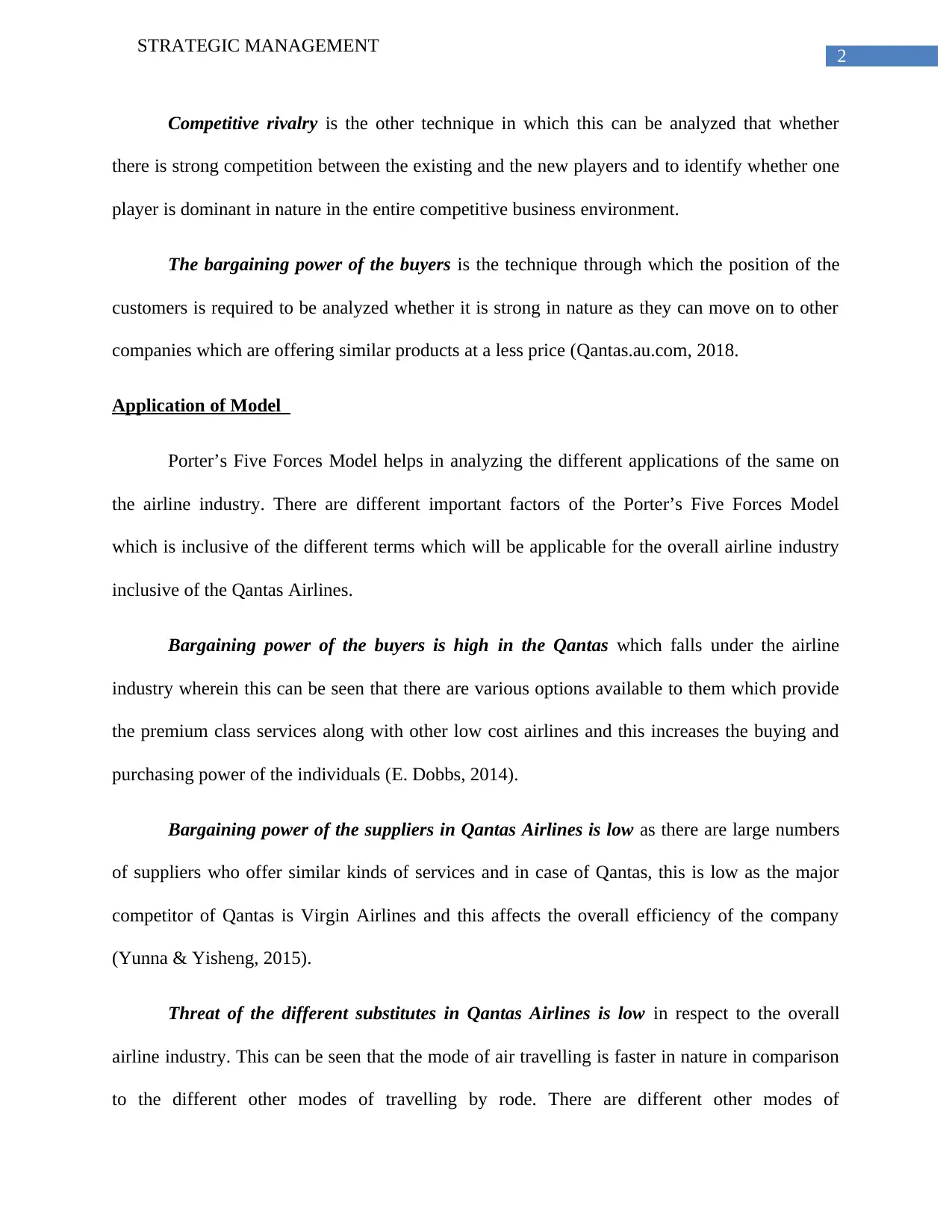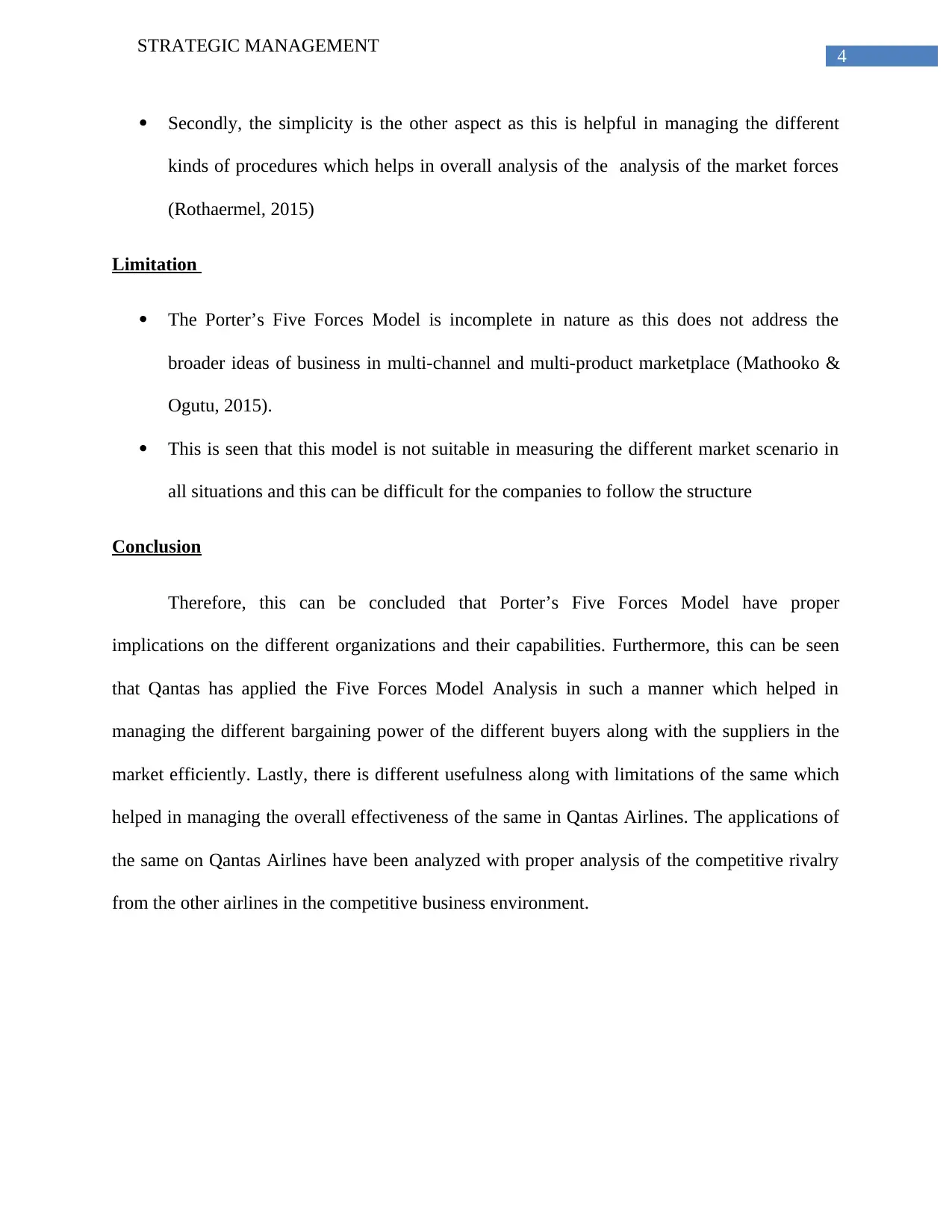Strategic Management: Porter’s Five Forces Model Application
VerifiedAdded on 2023/06/03
|6
|1498
|173
Essay
AI Summary
This essay provides a comprehensive analysis of Porter's Five Forces Model and its application within strategic management. It begins with a brief overview of the model, highlighting its components such as the threat of new entrants, the threat of substitutes, the bargaining power of suppliers and buyers, and competitive rivalry. The essay then delves into the practical application of the model to the airline industry, specifically focusing on Qantas Airlines, examining the bargaining power of buyers and suppliers, the threat of substitutes, rivalry among existing firms, and the threat of new entry. The analysis reveals that the most crucial aspect for Qantas Airlines is the rivalry among existing competitors. Furthermore, the essay discusses the usefulness of the model in providing a comprehensive view of competitive forces and its simplicity in managing market analysis, while also addressing its limitations, such as its incompleteness in multi-channel and multi-product marketplaces. The essay concludes that Porter’s Five Forces Model has significant implications for organizations and their strategic capabilities, offering valuable insights for managing competitive dynamics.

Running head: STRATEGIC MANAGEMENT
Strategic Management
Name of the Student
Name of the University
Author note
Strategic Management
Name of the Student
Name of the University
Author note
Paraphrase This Document
Need a fresh take? Get an instant paraphrase of this document with our AI Paraphraser

1
STRATEGIC MANAGEMENT
Introduction
The essay helps in the overall analysis of the Porter’s Five Forces Model which will be
applicable in the overall identification of the different capabilities of the same in the organization
efficiently. The usefulness and limitations of the Five Forces Model are required to be adopted
and analyzed in such a manner which will help in determining the competitive environment of
the organization and this affects the overall profitability. This model was created in order to
analyze the overall attractiveness of the industry along with the likely profitability as well. Porter
tried to keep a close eye on the rivals and their moves in order to gain knowledge.
Brief summary of Porter's Five Forces Model
According to Lin, (2017), the Porter’s Five Forces Model Analysis helps in determining
the competitive environment of the organization which affects the overall profitability of the
organization. The bargaining power of the buyers along with the different suppliers affect the
overall ability of the company in increasing prices along with managing the costs efficiently. The
five forces are inclusive of the following:
The threat of entry of the different competitors is helpful in analyzing how difficult it is
for the different new entrants to compete with the existing players in the market along with
identification of the different barriers to enter into the firm (Qantas.au.com, 2018).
The threat of substitutes is helpful in analyzing how easy it is for the companies to
substitute the different products along with services especially in a cheaper rate.
The bargaining power of suppliers is the technique which is helpful in analyzing how
strong the overall position is for the different buyers wherein they can work in a collaborative
manner to order the large volumes (Qantas.au.com, 2018.
STRATEGIC MANAGEMENT
Introduction
The essay helps in the overall analysis of the Porter’s Five Forces Model which will be
applicable in the overall identification of the different capabilities of the same in the organization
efficiently. The usefulness and limitations of the Five Forces Model are required to be adopted
and analyzed in such a manner which will help in determining the competitive environment of
the organization and this affects the overall profitability. This model was created in order to
analyze the overall attractiveness of the industry along with the likely profitability as well. Porter
tried to keep a close eye on the rivals and their moves in order to gain knowledge.
Brief summary of Porter's Five Forces Model
According to Lin, (2017), the Porter’s Five Forces Model Analysis helps in determining
the competitive environment of the organization which affects the overall profitability of the
organization. The bargaining power of the buyers along with the different suppliers affect the
overall ability of the company in increasing prices along with managing the costs efficiently. The
five forces are inclusive of the following:
The threat of entry of the different competitors is helpful in analyzing how difficult it is
for the different new entrants to compete with the existing players in the market along with
identification of the different barriers to enter into the firm (Qantas.au.com, 2018).
The threat of substitutes is helpful in analyzing how easy it is for the companies to
substitute the different products along with services especially in a cheaper rate.
The bargaining power of suppliers is the technique which is helpful in analyzing how
strong the overall position is for the different buyers wherein they can work in a collaborative
manner to order the large volumes (Qantas.au.com, 2018.

2
STRATEGIC MANAGEMENT
Competitive rivalry is the other technique in which this can be analyzed that whether
there is strong competition between the existing and the new players and to identify whether one
player is dominant in nature in the entire competitive business environment.
The bargaining power of the buyers is the technique through which the position of the
customers is required to be analyzed whether it is strong in nature as they can move on to other
companies which are offering similar products at a less price (Qantas.au.com, 2018.
Application of Model
Porter’s Five Forces Model helps in analyzing the different applications of the same on
the airline industry. There are different important factors of the Porter’s Five Forces Model
which is inclusive of the different terms which will be applicable for the overall airline industry
inclusive of the Qantas Airlines.
Bargaining power of the buyers is high in the Qantas which falls under the airline
industry wherein this can be seen that there are various options available to them which provide
the premium class services along with other low cost airlines and this increases the buying and
purchasing power of the individuals (E. Dobbs, 2014).
Bargaining power of the suppliers in Qantas Airlines is low as there are large numbers
of suppliers who offer similar kinds of services and in case of Qantas, this is low as the major
competitor of Qantas is Virgin Airlines and this affects the overall efficiency of the company
(Yunna & Yisheng, 2015).
Threat of the different substitutes in Qantas Airlines is low in respect to the overall
airline industry. This can be seen that the mode of air travelling is faster in nature in comparison
to the different other modes of travelling by rode. There are different other modes of
STRATEGIC MANAGEMENT
Competitive rivalry is the other technique in which this can be analyzed that whether
there is strong competition between the existing and the new players and to identify whether one
player is dominant in nature in the entire competitive business environment.
The bargaining power of the buyers is the technique through which the position of the
customers is required to be analyzed whether it is strong in nature as they can move on to other
companies which are offering similar products at a less price (Qantas.au.com, 2018.
Application of Model
Porter’s Five Forces Model helps in analyzing the different applications of the same on
the airline industry. There are different important factors of the Porter’s Five Forces Model
which is inclusive of the different terms which will be applicable for the overall airline industry
inclusive of the Qantas Airlines.
Bargaining power of the buyers is high in the Qantas which falls under the airline
industry wherein this can be seen that there are various options available to them which provide
the premium class services along with other low cost airlines and this increases the buying and
purchasing power of the individuals (E. Dobbs, 2014).
Bargaining power of the suppliers in Qantas Airlines is low as there are large numbers
of suppliers who offer similar kinds of services and in case of Qantas, this is low as the major
competitor of Qantas is Virgin Airlines and this affects the overall efficiency of the company
(Yunna & Yisheng, 2015).
Threat of the different substitutes in Qantas Airlines is low in respect to the overall
airline industry. This can be seen that the mode of air travelling is faster in nature in comparison
to the different other modes of travelling by rode. There are different other modes of
⊘ This is a preview!⊘
Do you want full access?
Subscribe today to unlock all pages.

Trusted by 1+ million students worldwide

3
STRATEGIC MANAGEMENT
transportation which is not suitable for travelling long distances and this can affect the overall
efficiency of the other modes of transport. But on the other hand, the threat of the different
substitutes is very low in nature (Zhao et al., 2016).
Rivalry among the other existing firms is crucial in terms of the overall airline industry
which is inclusive of the Qantas airlines. As per the overall current situation, this can be seen and
identified that the direct competition of Qantas Airlines in the entire Australian industry is Virgin
Atlantic Airlines in the entire domestic market (Indiatsy et al., 2014). Due to this, the other
airline companies in the overall competitive environment face tremendous competition and
severe losses in the operations (Qantas.au.com, 2018).
Threat of the new entry in the airline industry is lower in nature in comparison to the
other transportation modes. This has been identified that the airline transportation is the most
costly transportation in the entire world and this causes huge issues for the companies to invest in
such business and this will be difficult for them to handle such huge investments and capital
(Qantas.au.com, 2018).
From the entire analysis of the Five Forces Model, this can be analyzed and seen that the
main and crucial aspect for the Qantas Airlines which is required to be considered is the rivalry
among the existing competitors in the market as there are huge competitors which offer the
similar kind of products in the market.
Usefulness and Limitation
Usefulness
This helps in providing a comprehensive aspect which assists in helping in thinking of the
competitive forces contained within the business structure which is simple
STRATEGIC MANAGEMENT
transportation which is not suitable for travelling long distances and this can affect the overall
efficiency of the other modes of transport. But on the other hand, the threat of the different
substitutes is very low in nature (Zhao et al., 2016).
Rivalry among the other existing firms is crucial in terms of the overall airline industry
which is inclusive of the Qantas airlines. As per the overall current situation, this can be seen and
identified that the direct competition of Qantas Airlines in the entire Australian industry is Virgin
Atlantic Airlines in the entire domestic market (Indiatsy et al., 2014). Due to this, the other
airline companies in the overall competitive environment face tremendous competition and
severe losses in the operations (Qantas.au.com, 2018).
Threat of the new entry in the airline industry is lower in nature in comparison to the
other transportation modes. This has been identified that the airline transportation is the most
costly transportation in the entire world and this causes huge issues for the companies to invest in
such business and this will be difficult for them to handle such huge investments and capital
(Qantas.au.com, 2018).
From the entire analysis of the Five Forces Model, this can be analyzed and seen that the
main and crucial aspect for the Qantas Airlines which is required to be considered is the rivalry
among the existing competitors in the market as there are huge competitors which offer the
similar kind of products in the market.
Usefulness and Limitation
Usefulness
This helps in providing a comprehensive aspect which assists in helping in thinking of the
competitive forces contained within the business structure which is simple
Paraphrase This Document
Need a fresh take? Get an instant paraphrase of this document with our AI Paraphraser

4
STRATEGIC MANAGEMENT
Secondly, the simplicity is the other aspect as this is helpful in managing the different
kinds of procedures which helps in overall analysis of the analysis of the market forces
(Rothaermel, 2015)
Limitation
The Porter’s Five Forces Model is incomplete in nature as this does not address the
broader ideas of business in multi-channel and multi-product marketplace (Mathooko &
Ogutu, 2015).
This is seen that this model is not suitable in measuring the different market scenario in
all situations and this can be difficult for the companies to follow the structure
Conclusion
Therefore, this can be concluded that Porter’s Five Forces Model have proper
implications on the different organizations and their capabilities. Furthermore, this can be seen
that Qantas has applied the Five Forces Model Analysis in such a manner which helped in
managing the different bargaining power of the different buyers along with the suppliers in the
market efficiently. Lastly, there is different usefulness along with limitations of the same which
helped in managing the overall effectiveness of the same in Qantas Airlines. The applications of
the same on Qantas Airlines have been analyzed with proper analysis of the competitive rivalry
from the other airlines in the competitive business environment.
STRATEGIC MANAGEMENT
Secondly, the simplicity is the other aspect as this is helpful in managing the different
kinds of procedures which helps in overall analysis of the analysis of the market forces
(Rothaermel, 2015)
Limitation
The Porter’s Five Forces Model is incomplete in nature as this does not address the
broader ideas of business in multi-channel and multi-product marketplace (Mathooko &
Ogutu, 2015).
This is seen that this model is not suitable in measuring the different market scenario in
all situations and this can be difficult for the companies to follow the structure
Conclusion
Therefore, this can be concluded that Porter’s Five Forces Model have proper
implications on the different organizations and their capabilities. Furthermore, this can be seen
that Qantas has applied the Five Forces Model Analysis in such a manner which helped in
managing the different bargaining power of the different buyers along with the suppliers in the
market efficiently. Lastly, there is different usefulness along with limitations of the same which
helped in managing the overall effectiveness of the same in Qantas Airlines. The applications of
the same on Qantas Airlines have been analyzed with proper analysis of the competitive rivalry
from the other airlines in the competitive business environment.

5
STRATEGIC MANAGEMENT
References
E. Dobbs, M. (2014). Guidelines for applying Porter's five forces framework: a set of industry
analysis templates. Competitiveness Review, 24(1), 32-45.
Indiatsy, C. M., Mwangi, M. S., Mandere, E. N., Bichanga, J. M., & George, G. E. (2014). The
application of Porter’s five forces model on organization performance: A case of
cooperative bank of Kenya Ltd. European Journal of Business and Management, 6(16),
75-85.
Lin, B. (2017). Why Uber failed in China: a comparison of Uber and Didi Chuxing which based
on sharing economy in non-western context, through Michael Porter’s theory.
Mathooko, F. M., & Ogutu, M. (2015). Porter’s five competitive forces framework and other
factors that influence the choice of response strategies adopted by public universities in
Kenya. International Journal of Educational Management, 29(3), 334-354.
Qantas.au.com (2018) Fly with Australia’s most popular airline | Qantas AU. Retrieved from
https://www.qantas.com/au/en.html
Rothaermel, F. T. (2015). Strategic management. McGraw-Hill Education.
Yunna, W., & Yisheng, Y. (2014). The competition situation analysis of shale gas industry in
China: Applying Porter’s five forces and scenario model. Renewable and Sustainable
Energy Reviews, 40, 798-805.
Zhao, Z. Y., Zuo, J., Wu, P. H., Yan, H., & Zillante, G. (2016). Competitiveness assessment of
the biomass power generation industry in China: A five forces model study. Renewable
Energy, 89, 144-153.
STRATEGIC MANAGEMENT
References
E. Dobbs, M. (2014). Guidelines for applying Porter's five forces framework: a set of industry
analysis templates. Competitiveness Review, 24(1), 32-45.
Indiatsy, C. M., Mwangi, M. S., Mandere, E. N., Bichanga, J. M., & George, G. E. (2014). The
application of Porter’s five forces model on organization performance: A case of
cooperative bank of Kenya Ltd. European Journal of Business and Management, 6(16),
75-85.
Lin, B. (2017). Why Uber failed in China: a comparison of Uber and Didi Chuxing which based
on sharing economy in non-western context, through Michael Porter’s theory.
Mathooko, F. M., & Ogutu, M. (2015). Porter’s five competitive forces framework and other
factors that influence the choice of response strategies adopted by public universities in
Kenya. International Journal of Educational Management, 29(3), 334-354.
Qantas.au.com (2018) Fly with Australia’s most popular airline | Qantas AU. Retrieved from
https://www.qantas.com/au/en.html
Rothaermel, F. T. (2015). Strategic management. McGraw-Hill Education.
Yunna, W., & Yisheng, Y. (2014). The competition situation analysis of shale gas industry in
China: Applying Porter’s five forces and scenario model. Renewable and Sustainable
Energy Reviews, 40, 798-805.
Zhao, Z. Y., Zuo, J., Wu, P. H., Yan, H., & Zillante, G. (2016). Competitiveness assessment of
the biomass power generation industry in China: A five forces model study. Renewable
Energy, 89, 144-153.
⊘ This is a preview!⊘
Do you want full access?
Subscribe today to unlock all pages.

Trusted by 1+ million students worldwide
1 out of 6
Related Documents
Your All-in-One AI-Powered Toolkit for Academic Success.
+13062052269
info@desklib.com
Available 24*7 on WhatsApp / Email
![[object Object]](/_next/static/media/star-bottom.7253800d.svg)
Unlock your academic potential
Copyright © 2020–2025 A2Z Services. All Rights Reserved. Developed and managed by ZUCOL.





